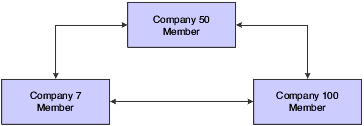Example: Configured Hub without Hub Company
This example shows the entries that the system creates when you have not designated a hub company (modified detail). In this example, one company (7) accrues a liability incurred by two companies (50 and 100). No hub company is designated, as illustrated:

You enter a journal entry that involves three companies:
Document |
Company |
Account |
Description |
Debit |
Credit |
|---|---|---|---|---|---|
JE 9100 |
50 |
50.8150 |
Expenses |
300 |
Blank |
JE 9100 |
100 |
100.8110 |
Expenses |
200 |
Blank |
JE 9100 |
7 |
7.4110 |
Accounts Payable |
Blank |
500 |
When you post the entry, the system automatically generates these intercompany entries:
Document |
Company |
Account/Sub/Type |
Description |
Debit |
Credit |
|---|---|---|---|---|---|
AE 9100 |
100 |
100.1291/00000050/A |
Intercompany Receivables/Payables |
Blank |
200 |
AE 9100 |
50 |
50.1291/00000100/A |
Intercompany Receivables/Payables |
200 |
Blank |
AE 9100 |
7 |
7.1291/00000050/A |
Intercompany Receivables/Payables |
500 |
Blank |
AE 9100 |
50 |
50.1291/00000007/A |
Intercompany Receivables/Payables |
Blank |
500 |
The second and fourth rows show the entries to the hub company (50) from companies 100 and 7. The automatic entries are identical to those that the system creates using configured hubs with a designated hub company. However, the company that is on the first line of the journal entry becomes the designated hub for the transaction.